 As I mentioned in the first part of my post, I had the opportunity to tour around Ft. Worth with journalists from around the world during the IFAJ conference. After leaving the Rocky Top Therapy Center we headed to the Texas Motor Speedway for a little fun on the track.
As I mentioned in the first part of my post, I had the opportunity to tour around Ft. Worth with journalists from around the world during the IFAJ conference. After leaving the Rocky Top Therapy Center we headed to the Texas Motor Speedway for a little fun on the track.
I’ve been to the speedway before and actually enjoyed watching the awe of our international friends more than anything. The speedway seats nearly 200,000 fans on a race weekend and is the host of two Nascar races and an IndyCar race. I could hardly believe this, but the speedway was completed in 1997 and in April ’97 had their first Nascar race. After the weekend was over, the owners made so much money they were able to pay off the speedway. Amazing!
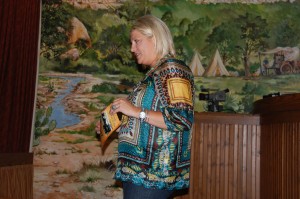 After watching some participants of the Richard Petty Driving School (a program where people can pay to learn how to drive a one of the race cars that compete in the Nascar Sprint Cup Series) with much jealousy, we headed to Superior Livestock Auction located in the historical Ft. Worth Stockyards. From the information that I can gather, they actually auctioned off livestock and other animals in the stockyards until the mid to late 90s. Now, many livestock auctions are handled online and Superior Livestock Auction is the company that pioneered the online auction. You can also watch the actions live on RFD TV and they will also soon be broadcast on cable. Nothing like the ability to buy a lot of Angus without leaving your couch.
After watching some participants of the Richard Petty Driving School (a program where people can pay to learn how to drive a one of the race cars that compete in the Nascar Sprint Cup Series) with much jealousy, we headed to Superior Livestock Auction located in the historical Ft. Worth Stockyards. From the information that I can gather, they actually auctioned off livestock and other animals in the stockyards until the mid to late 90s. Now, many livestock auctions are handled online and Superior Livestock Auction is the company that pioneered the online auction. You can also watch the actions live on RFD TV and they will also soon be broadcast on cable. Nothing like the ability to buy a lot of Angus without leaving your couch.
You can take a photo tour of my day by checking out our IFAJ/AMS 2009 Photo Album.




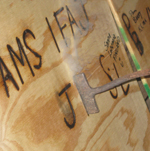 One of the coolest parts of the IFAJ/AMS Big Ol’ Western Welcome Party was pretty hot – branding boards with personal brands. Dozens of ag media types, both American and international, took the branding iron in hand and left their marks.
One of the coolest parts of the IFAJ/AMS Big Ol’ Western Welcome Party was pretty hot – branding boards with personal brands. Dozens of ag media types, both American and international, took the branding iron in hand and left their marks.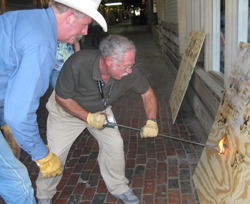 Our buddy Harlen Persinger – photographer extraordinaire – really got into it and designed a nice brand for himself. Check out the photo album for lots more photos.
Our buddy Harlen Persinger – photographer extraordinaire – really got into it and designed a nice brand for himself. Check out the photo album for lots more photos.
 Also featured at the ranch is a playground featuring the largest treehouse in the country. For the first time ever, both children and adults have been able to experience the pleasure of sliding down a topsy-turvy slide.
Also featured at the ranch is a playground featuring the largest treehouse in the country. For the first time ever, both children and adults have been able to experience the pleasure of sliding down a topsy-turvy slide.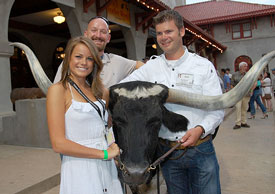 The International Federation of Ag Journalists kicked off the 2009 Congress events with an all American rodeo and some sweet southern cooking at
The International Federation of Ag Journalists kicked off the 2009 Congress events with an all American rodeo and some sweet southern cooking at 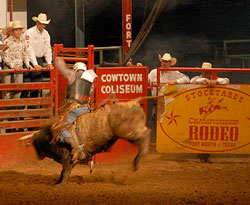 Inside the stadium you were greeted with the overwhelming aroma of livestock, all part of the experience, I guess. This was my first rodeo, as well as a first for most of the visitors to the conference and boy, was it a show! There was music, bull riding, calf roping, funny rodeo clowns, plenty to entertain us all. It was definitely a sight to see with something for everyone.
Inside the stadium you were greeted with the overwhelming aroma of livestock, all part of the experience, I guess. This was my first rodeo, as well as a first for most of the visitors to the conference and boy, was it a show! There was music, bull riding, calf roping, funny rodeo clowns, plenty to entertain us all. It was definitely a sight to see with something for everyone. 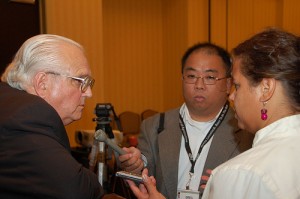
 The rain started at Burgundy Beef but were well informed on the all grass feeding of their cows and the complexity of the beef industry. We also sampled some of their meats and cheeses and had to brave the monsoon to make it back to our bus. The last stop on the tour was Beakley Farms, which is a family owned business that features cotton, wheat and sunflowers. We were unfortunately held on the bus for the majority of the time there but got off just long enough to peek at some of the equipment stored in the shed.
The rain started at Burgundy Beef but were well informed on the all grass feeding of their cows and the complexity of the beef industry. We also sampled some of their meats and cheeses and had to brave the monsoon to make it back to our bus. The last stop on the tour was Beakley Farms, which is a family owned business that features cotton, wheat and sunflowers. We were unfortunately held on the bus for the majority of the time there but got off just long enough to peek at some of the equipment stored in the shed.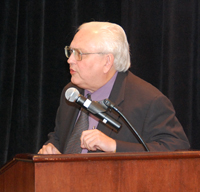 It was the Flinchbaugh-Stenholm show Sunday morning at the first combined session for the IFAJ Congress and the Ag Media Summit. A full house was entertained by the musings and mutterings of “The Great Debate” between former Texas congressman Charlie Stenholm and retired K-State ag economist Barry Flichbaugh.
It was the Flinchbaugh-Stenholm show Sunday morning at the first combined session for the IFAJ Congress and the Ag Media Summit. A full house was entertained by the musings and mutterings of “The Great Debate” between former Texas congressman Charlie Stenholm and retired K-State ag economist Barry Flichbaugh. The crowd had lots of questions for the two after their debate over ag and international trade policy, as did several reporters after the fact. It was interesting to hear the international journalists ask questions about climate change policy and animal rights activism. Our own Joanna Schroeder and Kansas Ag Network reporter Greg Akagi also interviewed them both.
The crowd had lots of questions for the two after their debate over ag and international trade policy, as did several reporters after the fact. It was interesting to hear the international journalists ask questions about climate change policy and animal rights activism. Our own Joanna Schroeder and Kansas Ag Network reporter Greg Akagi also interviewed them both. 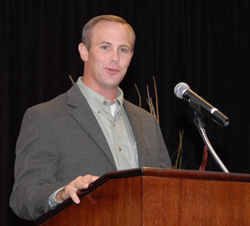 During an interview after his luncheon address, Drew DeBerry told me that he was not surprised with the reaction to some of his comments and the questions posed by the international journalists. “I’m impressed at the interest they have in our domestic policies here in the United States,” he said. “I’m encouraged that means there is an interest around the world in better understanding US domestic policies because we have to understand each others policies if we’re going to have fair trade.”
During an interview after his luncheon address, Drew DeBerry told me that he was not surprised with the reaction to some of his comments and the questions posed by the international journalists. “I’m impressed at the interest they have in our domestic policies here in the United States,” he said. “I’m encouraged that means there is an interest around the world in better understanding US domestic policies because we have to understand each others policies if we’re going to have fair trade.”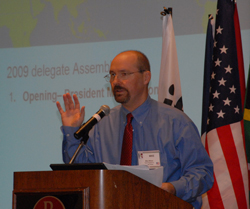 Mike reported on the further development of the
Mike reported on the further development of the